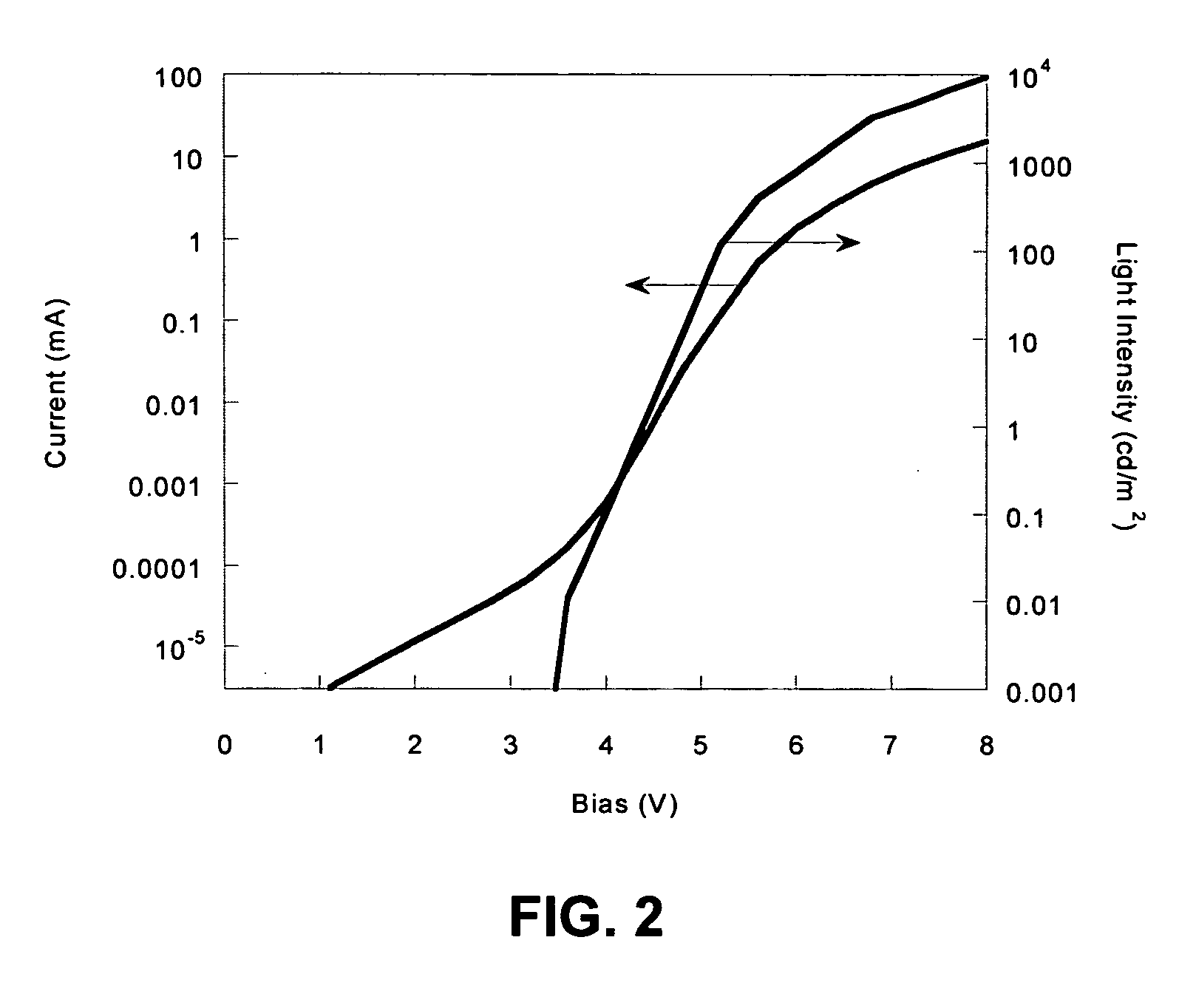Electroluminescent polymers and use thereof in light-emitting devices
a technology of electroluminescent polymers and light-emitting devices, which is applied in the field of electroluminescent polymers, can solve the problems of requiring a high operating voltage (and lifetime), lag in power efficiency of blue-emitting polymers, and prone to redshifting
- Summary
- Abstract
- Description
- Claims
- Application Information
AI Technical Summary
Benefits of technology
Problems solved by technology
Method used
Image
Examples
example 1
Syntesis of 4,4′-Dibromo-2-Diphenylamino-1,1′-Biphenyl
4,4′-Dibromo-2-amino-1,1′-biphenyl (16.35 g, prepared according to Libman and Slack (1951) J. Chem. Soc., p. 2588), iodobenzene (26.52 g, 0.13 mol), flake potassium hydroxide (22.4 g, 0.35 mol), 1,10-phenanthroline (0.45 g), copper (I) chloride (0.25 g), and toluene (30 ml) were charged into a flask and stirred at reflux for 15 hours. The dark reaction mixture was cooled to room temperature and diluted with 200 ml of toluene. The toluene solution was washed with DI water, dried with magnesium sulfate, and evaporated. The dark residue obtained was recrystallized trice from hexane / toluene (4:1 volume) to yield 10 grams of white crystals to yield the desired monomer. 1H NMR (CDCl3): δ=6.8-7.5, multiple peaks.
example 2
Synthesis of 4,4′-Dibromo-2-Bis(4-Methoxyphenyl)Amino-1,1′-Biphenyl
4,4′-Dibromo-2-amino-1,1′-biphenyl (16.35 g, 0.05 mol), 4-iodoanisole (28 g, 0.12 mol), potassium carbonate (−325 mesh fine powder, 16.6 g, 0.12 mole), copper dust (−150 mesh,1.0 g), and nitrobenzene (20 ml) were charged into a flask and stirred at gentle reflux for 15 hours. The dark reaction mixture was cooled to room temperature and extracted with 200 ml of toluene. The toluene solution was evaporated. The dark residue obtained was then mixed with 10 ml of toluene and chromatographed on a silica gel column using hexane and hexane / ethyl acetate (20:1) eluant. The portions containing the product were collected and evaporated. The residue was recrystallized twice from hexane / toluene (300 ml / 60 ml) to yield 7.4 grams of off-white crystals of the desired monomer. 1H NMR (CDCl3): δ=6.8-7.5 (15H, multiple peaks); 3.78 (6H).
example 3
Synthesis of 4,4′-Dibromo-2-Dioctylamino-1,1′-Biphenyl
The reaction of Example 1 was repeated, except that 1-bromooctane (25.09 g, 0.13 mole) was used in place of iodobenzene. The product was purified by column chromatography on silica gel using hexanes as eluant.
PUM
| Property | Measurement | Unit |
|---|---|---|
| Time | aaaaa | aaaaa |
| Structure | aaaaa | aaaaa |
| Solubility (mass) | aaaaa | aaaaa |
Abstract
Description
Claims
Application Information
 Login to View More
Login to View More - R&D
- Intellectual Property
- Life Sciences
- Materials
- Tech Scout
- Unparalleled Data Quality
- Higher Quality Content
- 60% Fewer Hallucinations
Browse by: Latest US Patents, China's latest patents, Technical Efficacy Thesaurus, Application Domain, Technology Topic, Popular Technical Reports.
© 2025 PatSnap. All rights reserved.Legal|Privacy policy|Modern Slavery Act Transparency Statement|Sitemap|About US| Contact US: help@patsnap.com



